Four Multi-GPU Z77 Boards from $280-$350 - PLX PEX 8747 featuring Gigabyte, ASRock, ECS and EVGA
by Ian Cutress on August 22, 2012 9:15 AM ESTGigabyte G1.Sniper 3 Software
Much like the BIOS in the G1.Sniper 3 is essentially identical to that found in the Z77X-UD5H, there is not much difference in the software either. We still have the main stables of the software – EasyTune6 for monitoring and overclocking, @BIOS for updating the BIOS and 3D BIOS to adjust LLC settings and the power delivery on the fly. Due to some of the extra feature adjustments on the G1.Sniper 3 over the UD5H though, we also have software to manage the Qualcomm Atheros Killer Network controller, as well as the Creative audio chip on board.
For installation of the software and drivers, the install CD that comes with the motherboard is simple to use – a one button click will install all the drivers and most of the software, including those needed for extra controllers and EasyTune6. 3D BIOS and software to enable 3TB hard drives is not installed by default however – these can be manually selected via the options menu. One other feature that we have not covered before, Gigabyte TweakLauncher, has to be downloaded from the website to be installed. This ‘new’ software is described below. After we finished testing the motherboard, Gigabyte released new software called ‘USB Blocker’ designed to restrict unwanted USB devices. We will be covering this software in a later review, however it will be available for the G1.Sniper 3.
EasyTune6
EasyTune 6 is Gigabyte’s attempt to bring together a lot of the functionality that the software should do in one package. Through ET6, we can perform automatic overclocking or manual overclocking, gather information regarding the system and the CPU being used, adjust the fan settings, or monitor the hardware voltages and temperatures.
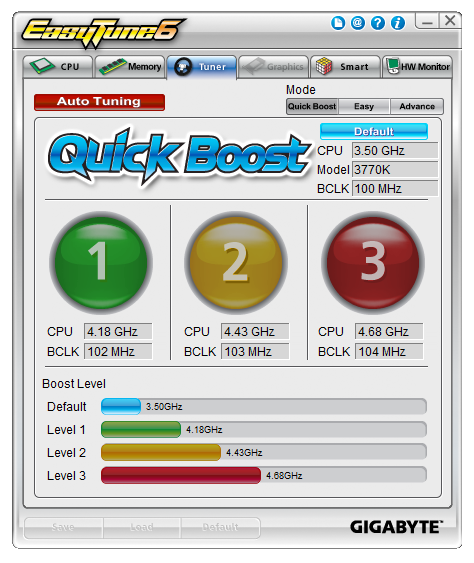
The first menu of ET6 takes us to the Tuner menu, which offers three level of overclocks (as shown above) as well as an ‘Auto Tuning’ option. The effect of these buttons is described in our overclocking section for this motherboard. Under the ‘Easy’ and ‘Advance’ options in the top right of the Tuner tab, we can explore the multiplier and voltage adjustments that ET6 allows:
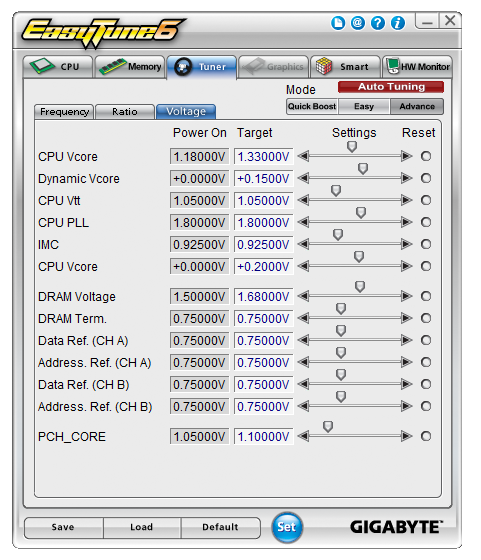
The main take-home point of ET6, apart from the fact that it is starting to look a little dated as it has not changed in at least 18 months, is that the fan controls are awkward compared to those provided by other manufacturers.

Users can set the CPU fan, the System fans, or the second series of fans as part of three different series each with their own ramp from a low speed to a high speed. These fan controls are easier to digest than those found in the BIOS, but Gigabyte needs to invest a bit more into their fan controllers and also the software that comes with controlling them.
It is also worth pointing out that ET6 still has the issue plaguing our Deferred Procedure Call testing, which determines how smoothly the processor goes through requests. Due to the monitoring software of ET6, every few seconds it causes the DPC to rise to 20 times its normal value. This can have serious effects in audio processing, introducing offsets of a couple of milliseconds. This situation can be avoided by turning off the ET6 software.
Qualcomm Atheros Killer Network Manager
As the Gigabyte G1.Sniper 3 comes with a Killer NIC onboard, there is also software designed to help manage this functionality. The Killer NIC is designed to prioritize certain kinds of traffic over others as well as reduce CPU usage, such that playing video games either at a LAN or on the internet is not disturbed by the network interface. This system is a combination of hardware and software, and the software allows for that priority configuration to be manipulated.
Users will notice a new icon in their task bar when the software is installed, which will bring up the following ‘Overview’ screen of the software:
The software gives a good overview of the system being used, but the crucial options are found in the applications menu.
This allows users to see all the programs that request network services, and then give them a rating to indicate which ones have priority. For most gamers, this puts the game and any VOIP at the top priority, and everything else at the lowest. If the lowest priority programs request more networking resources when the priority programs require them, then the low priority requests are throttled. Users can also monitor the data through the network port though this tool.
SoundBlaster THX TruStudio
Similar to the software management of the Killer NIC, the Creative audio chip on board has its own set of software utilities to manage the sound delivery on the motherboard. The software comes in the form of SoundBlaster THX TruStudio, and offers customization of all the audio ports in terms to an equalizer, setup, and enhanced voice controls. As part of this package, there is also proprietary post-audio processing technology to enhance audio related to in-game footsteps, to help determine when that enemy is creeping up behind you.
@BIOS
Users have two options to update the BIOS on a Gigabyte motherboard – if you have access to the internet via another computer and a USB stick, the BIOS can be updated through the BIOS itself and the Q-Flash utility. If that is not available (or the new BIOS is sufficiently different such that Q-Flash does not recognize the new BIOS), then in the operating system @BIOS can be used. The @BIOS system can check the Gigabyte servers for the latest BIOS for the motherboard and download it appropriately.
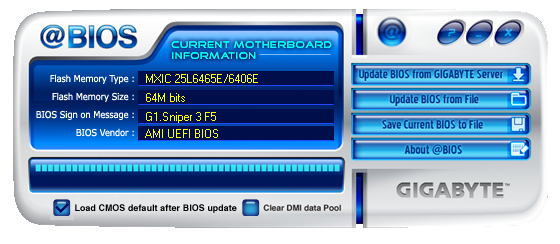
Gigabyte TweakLauncher (GBTL)
One relatively new bit of software to be released alongside Z77 motherboards is the Gigabyte TweakLauncher. This software is designed for competitive overclocking rather than any other overclocking, as it takes the entire GUI out of the overclock options in ET6 and gives the user the bare basics to give on-the-fly adjustments. This software is not available on the CD, but only through a download on the Gigabyte website.
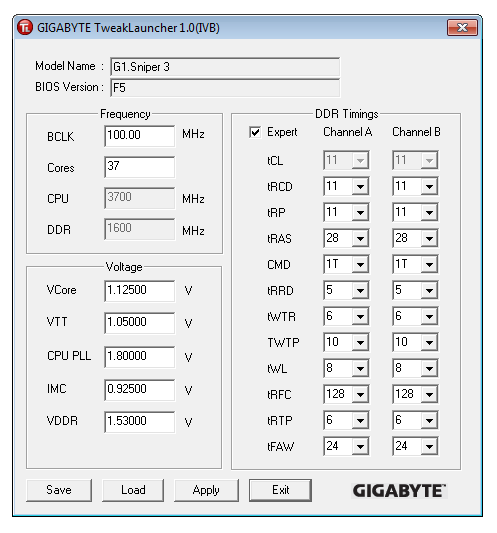


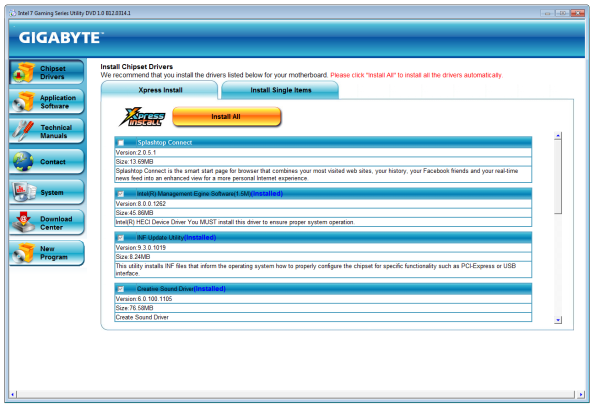
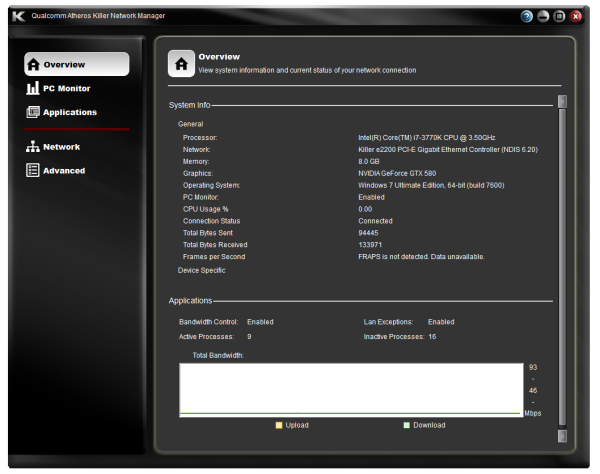
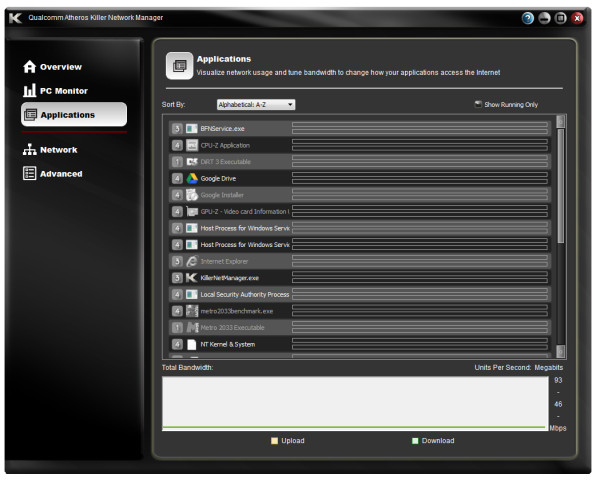
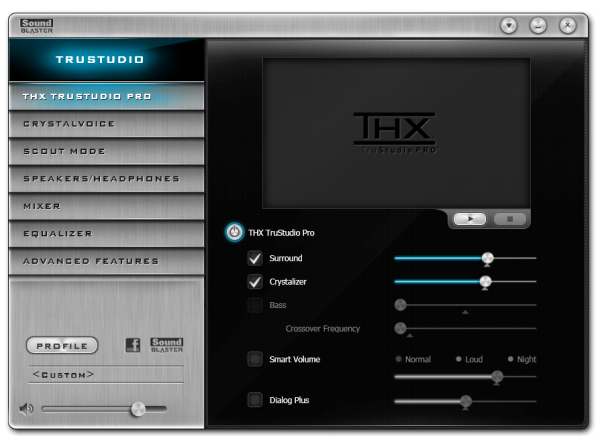
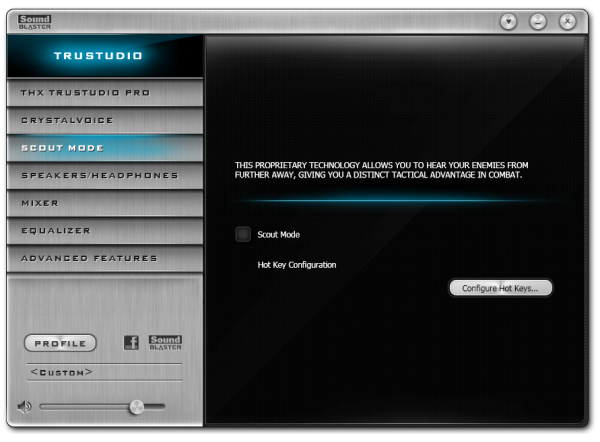














24 Comments
View All Comments
goinginstyle - Thursday, August 23, 2012 - link
I tried the G1 Sniper 3 and returned it a few days later. The audio was a significant downgrade from the Assassin series, EFI is clunky at best and the board had serious problems with a GSKill 16GB 2666 kit, not to mention the lousy fan controls.Purchased a Maximus Formula V and never looked back as the EFI, Fan Controls, Clocking and Audio are much better in every way compared to the Sniper board. There is no way Gigabyte has brought better value than ASUS with the Z77 chipset. You get what you pay for and the GB is overpriced once you actually use the board and compare it to ASUS or even ASRock.
JohnBS - Thursday, November 1, 2012 - link
I am looking for a rock solid MB, so of course I turned to ASUS. However, the reviews from verified buyers showed multiple issues with 3.0 USB ports losing power, system instability after months of use, and multiple instances of the board not working in one or more memory slots. Bent pins from the factory and complete DOA issues as well. A few reports of complete failure when the Wi-Fi card was inserted, yet gone with the card removed. This was mainly the Maximus IV series. Then I thought I'd look into the Maximus V series, because I really wanted ASUS, and was kinda sad to read reviews. Same issues from verified buyers of the Maximus V, more so with the USB 3.0 problems and the Wi-Fi/Bluetooth add-on card failures. In common were multiple complaints about customer service.So I emailed the ASUS rep who was replying to everyone's post, with specific attention on the recurring problems and how I was concerned about buying a MB. I got the email back, stating they were aware of the recurring problems listed on the user reviews, but that they are isolated occurrences.
I really need a rock solid x16 x 2 pci-e mb right now, and that's why I'm still searching. I'm planning on overclocking an i7-2700k with an gtx 690 and a 120z monitor for high res gaming. The sniper 3 looks good, but the front audio plug reaching the board's bottom audio header might be something I can't work around.
Just want something reliable. If there's a known issue, I'm always in that percentile that gets hit with the RMA process. I'm trying so hard to avoid that.
(Went with 690 instead of dual 680 for heat, noise, power draw considerations).
jonjonjonj - Friday, October 26, 2012 - link
you mean gigabyte in the evga conclusion?"the EVGA does not keep pace with ASUS and EVGA even at stock speeds."
couchassault9001 - Friday, November 2, 2012 - link
So for gaming benchmarks is it correct that the cpu multipliers were at 40 on the g1.sniper and 36 on the evga? if so it seems to be a rather unfair comparison. Being that the sniper cpu is running 11% fasterI'd be amazed if someone was looking at these boards with no intent to overclock like crazy, as i'm trying to decide between these 2 boards myself, and i'm sure i'll be pushing my 3770k as far as it will go.
The evga consumed ~8% less power than the sniper under load.
dirt 3 showed a 9% frame rate drop in the frame rate going from g1 to evga. metro 2033 showed a 3.6% drop in frame rate going from g1 to evga. Both of these are on the 4 7970 benchmarks. the 3 and below the gap is much tighter with it being under 1% with one card.
I know this may be nit picking to some, but i plan on running 5760x1080 3d so 4 7970 performance on a i7-3770k is exactly what i'm looking at.